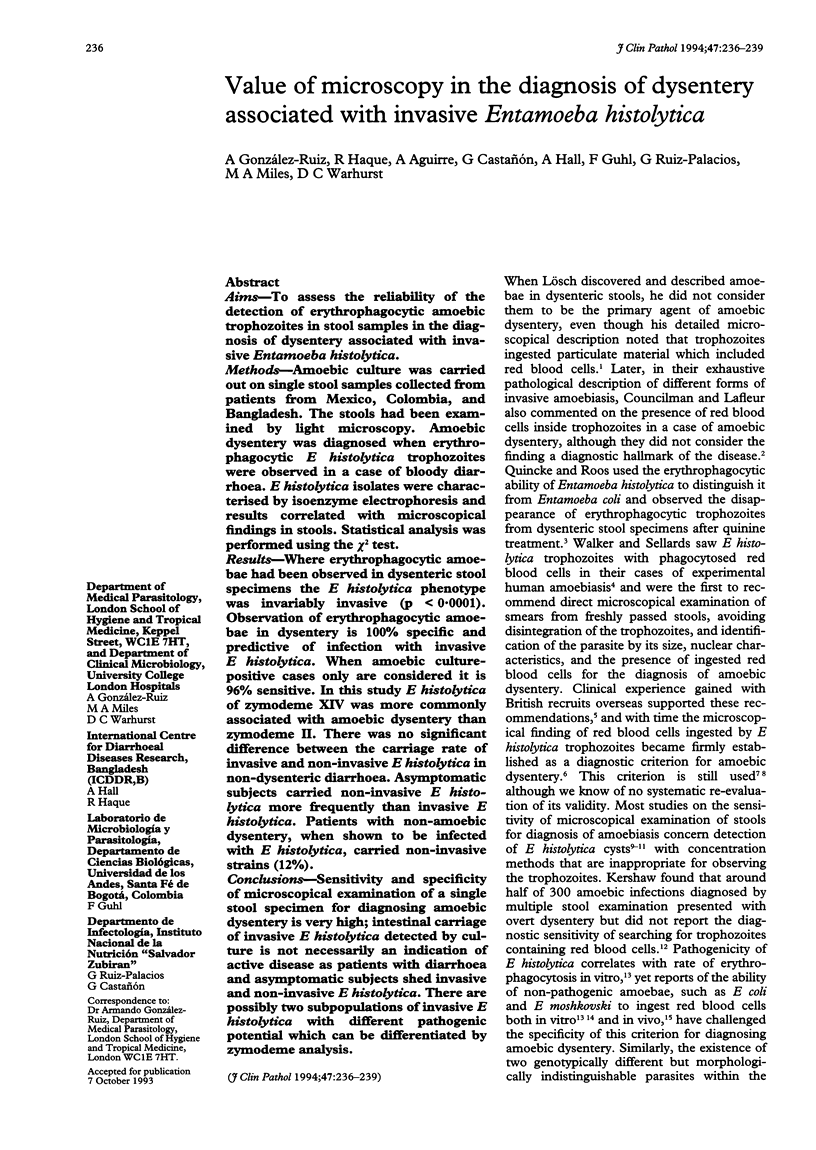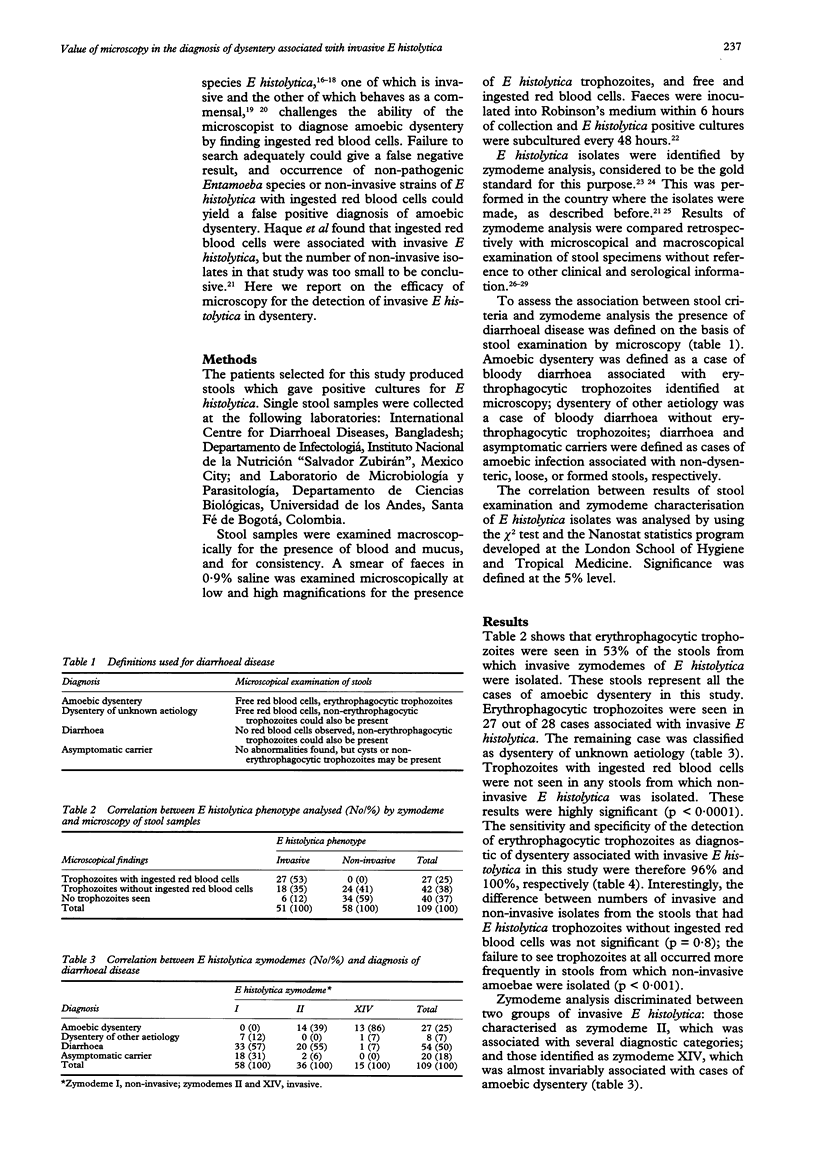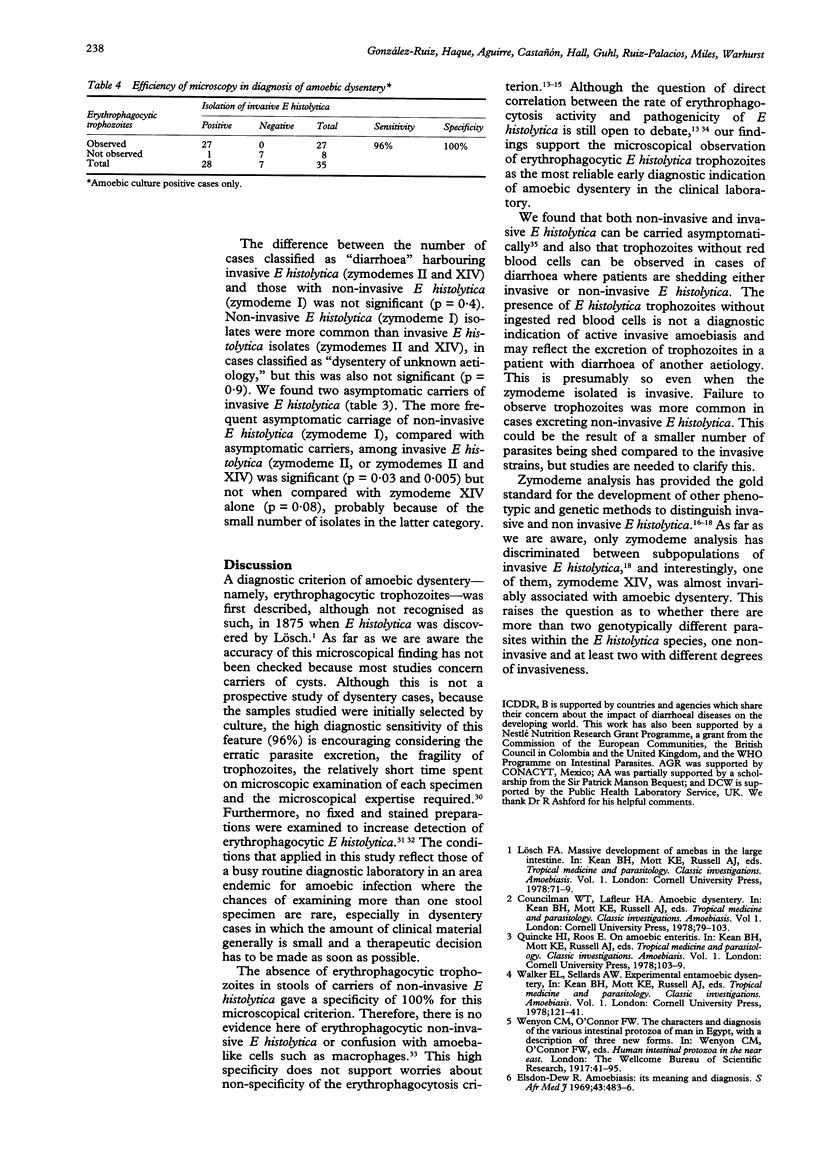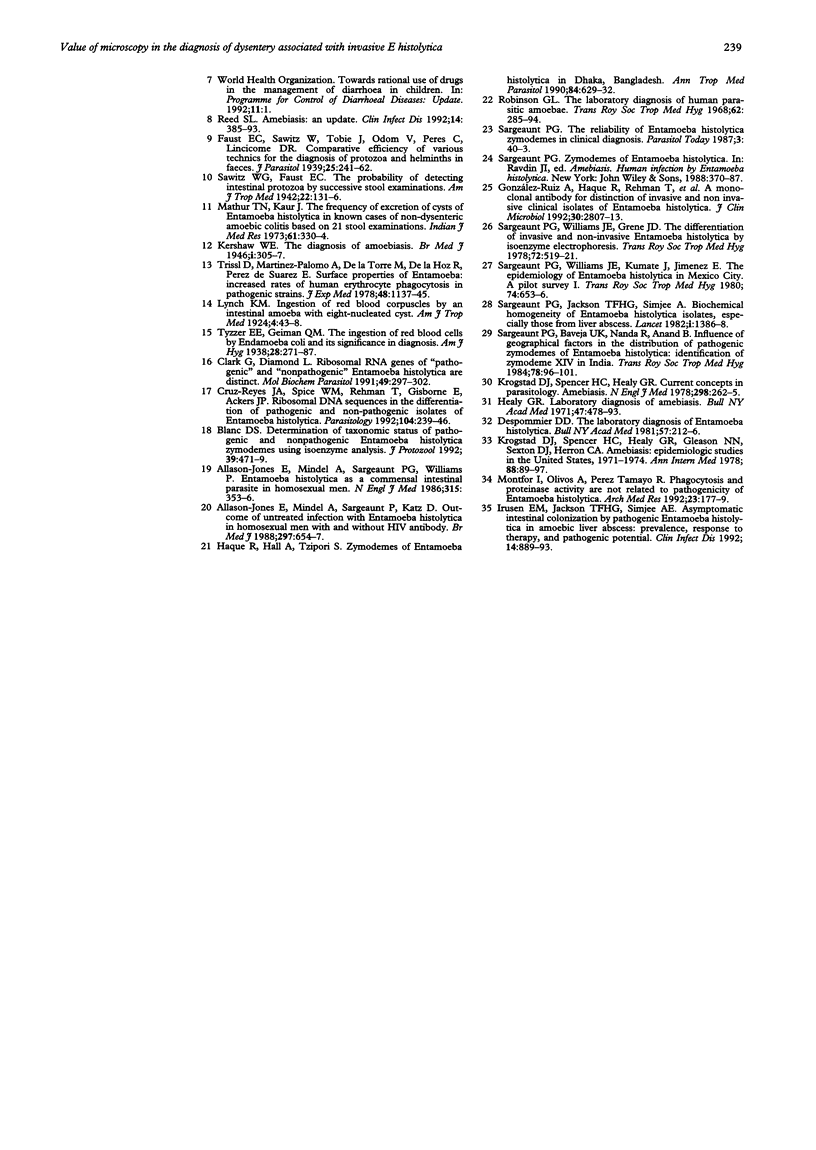Abstract
AIMS--To assess the reliability of the detection of erythrophagocytic amoebic trophozoites in stool samples in the diagnosis of dysentery associated with invasive Entamoeba histolytica. METHODS--Amoebic culture was carried out on single stool samples collected from patients from Mexico, Colombia, and Bangladesh. The stools had been examined by light microscopy. Amoebic dysentery was diagnosed when erythrophagocytic E histolytica trophozoites were observed in a case of bloody diarrhoea. E histolytica isolates were characterised by isoenzyme electrophoresis and results correlated with microscopical findings in stools. Statistical analysis was performed using the chi 2 test. RESULTS--Where erythrophagocytic amoebae had been observed in dysenteric stool specimens the E histolytica phenotype was invariably invasive (p < 0.0001). Observation of erythrophagocytic amoebae in dysentery is 100% specific and predictive of infection with invasive E histolytica. When amoebic culture-positive cases only are considered it is 96% sensitive. In this study E histolytica of zymodeme XIV was more commonly associated with amoebic dysentery than zymodeme II. There was no significant difference between the carriage rate of invasive and non-invasive E histolytica in non-dysenteric diarrhoea. Asymptomatic subjects carried non-invasive E histolytica more frequently than invasive E histolytica. Patients with non-amoebic dysentery, when shown to be infected with E histolytica, carried non-invasive strains (12%). CONCLUSIONS--Sensitivity and specificity of microscopical examination of a single stool specimen for diagnosing amoebic dysentery is very high; intestinal carriage of invasive E histolytica detected by culture is not necessarily an indication of active disease as patients with diarrhoea and asymptomatic subjects shed invasive and non-invasive E histolytica. There are possibly two subpopulations of invasive E histolytica with different pathogenic potential which can be differentiated by zymodeme analysis.
Full text
PDF



Selected References
These references are in PubMed. This may not be the complete list of references from this article.
- Allason-Jones E., Mindel A., Sargeaunt P., Katz D. Outcome of untreated infection with Entamoeba histolytica in homosexual men with and without HIV antibody. BMJ. 1988 Sep 10;297(6649):654–657. doi: 10.1136/bmj.297.6649.654. [DOI] [PMC free article] [PubMed] [Google Scholar]
- Allason-Jones E., Mindel A., Sargeaunt P., Williams P. Entamoeba histolytica as a commensal intestinal parasite in homosexual men. N Engl J Med. 1986 Aug 7;315(6):353–356. doi: 10.1056/NEJM198608073150603. [DOI] [PubMed] [Google Scholar]
- Blanc D. S. Determination of taxonomic status of pathogenic and nonpathogenic Entamoeba histolytica zymodemes using isoenzyme analysis. J Protozool. 1992 Jul-Aug;39(4):471–479. doi: 10.1111/j.1550-7408.1992.tb04834.x. [DOI] [PubMed] [Google Scholar]
- Clark C. G., Diamond L. S. Ribosomal RNA genes of 'pathogenic' and 'nonpathogenic' Entamoeba histolytica are distinct. Mol Biochem Parasitol. 1991 Dec;49(2):297–302. doi: 10.1016/0166-6851(91)90073-f. [DOI] [PubMed] [Google Scholar]
- Cruz-Reyes J. A., Spice W. M., Rehman T., Gisborne E., Ackers J. P. Ribosomal DNA sequences in the differentiation of pathogenic and non-pathogenic isolates of Entamoeba histolytica. Parasitology. 1992 Apr;104(Pt 2):239–246. doi: 10.1017/s0031182000061679. [DOI] [PubMed] [Google Scholar]
- Despommier D. D. The laboratory diagnosis of Entamoeba histolytica. Bull N Y Acad Med. 1981 Apr;57(3):212–216. [PMC free article] [PubMed] [Google Scholar]
- Elsdon-Dew R. Amoebiasis: its meaning and diagnosis. S Afr Med J. 1969 Apr 19;43(16):483–486. [PubMed] [Google Scholar]
- Gonzalez-Ruiz A., Haque R., Rehman T., Aguirre A., Jaramillo C., Castañon G., Hall A., Guhl F., Ruiz-Palacios G., Warhurst D. C. A monoclonal antibody for distinction of invasive and noninvasive clinical isolates of Entamoeba histolytica. J Clin Microbiol. 1992 Nov;30(11):2807–2813. doi: 10.1128/jcm.30.11.2807-2813.1992. [DOI] [PMC free article] [PubMed] [Google Scholar]
- Haque R., Hall A., Tzipori S. Zymodemes of Entamoeba histolytica in Dhaka, Bangladesh. Ann Trop Med Parasitol. 1990 Dec;84(6):629–632. doi: 10.1080/00034983.1990.11812519. [DOI] [PubMed] [Google Scholar]
- Healy G. R. Laboratory diagnosis of amebiasis. Bull N Y Acad Med. 1971 May;47(5):478–493. [PMC free article] [PubMed] [Google Scholar]
- Irusen E. M., Jackson T. F., Simjee A. E. Asymptomatic intestinal colonization by pathogenic Entamoeba histolytica in amebic liver abscess: prevalence, response to therapy, and pathogenic potential. Clin Infect Dis. 1992 Apr;14(4):889–893. doi: 10.1093/clinids/14.4.889. [DOI] [PubMed] [Google Scholar]
- Kershaw W. E. The Diagnosis of Amoebiasis. Br Med J. 1946 Mar 2;1(4443):305–307. [PMC free article] [PubMed] [Google Scholar]
- Krogstad D. J., Spencer H. C., Jr, Healy G. R. Current concepts in parasitology. Amebiasis. N Engl J Med. 1978 Feb 2;298(5):262–265. doi: 10.1056/NEJM197802022980507. [DOI] [PubMed] [Google Scholar]
- Krogstad D. J., Spencer H. C., Jr, Healy G. R., Gleason N. N., Sexton D. J., Herron C. A. Amebiasis: epidemiologic studies in the United States, 1971-1974. Ann Intern Med. 1978 Jan;88(1):89–97. doi: 10.7326/0003-4819-88-1-89. [DOI] [PubMed] [Google Scholar]
- Mathur T. N., Kaur J. The frequency of excretion of cysts of Entamoeba histolytica in known cases of non-dysenteric amoebic colitis based on 21 stool examinations. Indian J Med Res. 1973 Mar;61(3):330–334. [PubMed] [Google Scholar]
- Montfort I., Olivos A., Pérez Tamayo R. Phagocytosis and proteinase activity are not related to pathogenicity of Entamoeba histolytica. Arch Med Res. 1992;23(2):177–179. [PubMed] [Google Scholar]
- Reed S. L. Amebiasis: an update. Clin Infect Dis. 1992 Feb;14(2):385–393. doi: 10.1093/clinids/14.2.385. [DOI] [PubMed] [Google Scholar]
- Robinson G. L. The laboratory diagnosis of human parasitic amoebae. Trans R Soc Trop Med Hyg. 1968;62(2):285–294. doi: 10.1016/0035-9203(68)90170-3. [DOI] [PubMed] [Google Scholar]
- Sargeaunt P. G., Baveja U. K., Nanda R., Anand B. S. Influence of geographical factors in the distribution of pathogenic zymodemes of Entamoeba histolytica: identification of zymodeme XIV in India. Trans R Soc Trop Med Hyg. 1984;78(1):96–101. doi: 10.1016/0035-9203(84)90185-8. [DOI] [PubMed] [Google Scholar]
- Sargeaunt P. G., Jackson T. F., Simjee A. Biochemical homogeneity of Entamoeba histolytica isolates, especially those from liver abscess. Lancet. 1982 Jun 19;1(8286):1386–1388. doi: 10.1016/s0140-6736(82)92502-8. [DOI] [PubMed] [Google Scholar]
- Sargeaunt P. G. The reliability of Entamoeba histolytica zymodemes in clinical diagnosis. Parasitol Today. 1987 Feb;3(2):40–37. doi: 10.1016/0169-4758(87)90211-0. [DOI] [PubMed] [Google Scholar]
- Sargeaunt P. G., Williams J. E., Grene J. D. The differentiation of invasive and non-invasive Entamoeba histolytica by isoenzyme electrophoresis. Trans R Soc Trop Med Hyg. 1978;72(5):519–521. doi: 10.1016/0035-9203(78)90174-8. [DOI] [PubMed] [Google Scholar]
- Sargeaunt P. G., Williams J. E., Kumate J., Jimenez E. The epidemiology of Entamoeba histolytica in Mexico City. A pilot survey I. Trans R Soc Trop Med Hyg. 1980;74(5):653–656. doi: 10.1016/0035-9203(80)90158-3. [DOI] [PubMed] [Google Scholar]
- Trissl D., Martínez-Palomo A., de la Torre M., de la Hoz R., Pérez de Suárez E. Surface properties of Entamoeba: increased rates of human erythrocyte phagocytosis in pathogenic strains. J Exp Med. 1978 Nov 1;148(5):1137–1143. doi: 10.1084/jem.148.5.1137. [DOI] [PMC free article] [PubMed] [Google Scholar]


